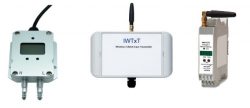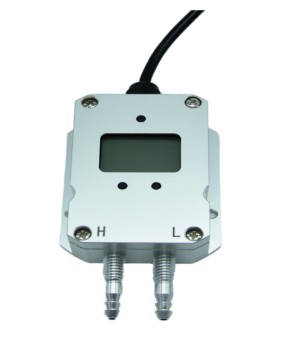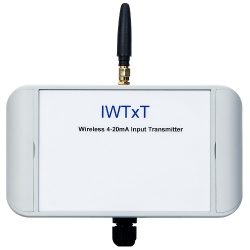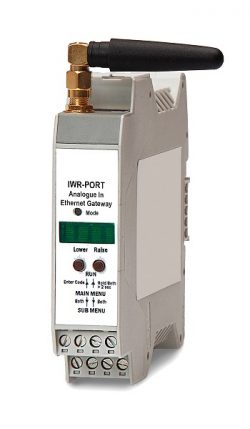
This application required a solution for monitoring low-range differential pressure in controlled rooms where installing new signal cabling was not feasible. The system needed to be entirely local and capable of integrating with an existing SCADA system using Modbus RS485. The final solution successfully addressed these challenges by combining wired sensors with a battery-powered wireless network.
- Challenge: Wireless monitoring of room pressurization without relying on cloud services.
- System Constraint: Must provide data to a local SCADA system via Modbus RS485.
- Power Constraint: The remote sensor and transmitter assembly required a battery-powered solution.
- Solution: A low-pressure differential pressure sensor connected to a battery-powered wireless 4-20mA transmitter, which communicates with a central Modbus gateway receiver.
A customer was tasked with implementing a monitoring system for room overpressure within a facility. The application is common in controlled environments like cleanrooms, laboratories, or isolation rooms, where maintaining a specific positive pressure differential relative to adjacent areas is critical to prevent the ingress of contaminants. The primary challenge was the infrastructure; the rooms requiring monitoring were designated as safe areas, but the surrounding plant environment made the installation of new, hard-wired signal cabling for conventional sensors both difficult and cost-prohibitive. To overcome this, a wireless solution was essential. The system had to be entirely self-contained on the local network, with no reliance on external internet or cloud services. A crucial requirement was the ability for the new sensor network to integrate seamlessly into an existing third-party SCADA system using the Modbus RS485 communication protocol, allowing for centralized data logging, trend analysis, and the potential to trigger alarms or control HVAC systems.
The proposed solution centered on a multi-component system designed for flexibility and ease of integration. For the primary measurement, a differential pressure transmitter from the II-DP-CR-00 series was selected. This sensor is specifically designed for measuring the very low gauge pressures typical of room pressurization applications and provides a robust, industry-standard 4-20mA analog output signal. To eliminate the need for signal wiring, the 4-20mA output from each differential pressure sensor was connected to a dedicated IWTxT series wireless transmitter. A key feature of this transmitter, and a critical factor in this application, is its ability to not only transmit the sensor’s signal but also to provide the necessary excitation voltage to power the sensor itself. This function allows a standard wired sensor to be converted into a completely wireless, battery-operated node.
A significant technical consideration was the power management of the remote sensor nodes, as the customer required a fast data update rate of one reading per second. The IWTxT transmitter utilizes an intelligent power-cycling strategy to conserve energy; it momentarily powers up the connected 4-20mA sensor, allows the reading to stabilize, transmits the data wirelessly, and then powers the sensor back down. While the transmitter’s internal battery for the wireless modem is optimized for long life, the separate internal battery used to power the external sensor would be depleted rapidly at such a high sampling rate. To meet the customer’s requirement for both a fast update rate and a practical maintenance interval, the solution included the option of connecting an external, high-capacity rechargeable battery pack to the transmitter, extending its operational life to many months between charges. For applications with less stringent monitoring requirements, the user can easily select a slower transmission rate, such as every 10 or 60 seconds, to dramatically prolong the life of the standard internal batteries.
To receive and consolidate the data from the various wireless sensor nodes, a single IWR-PORT series gateway was installed in a central control panel. This DIN-rail mountable receiver, powered by a standard 24Vdc supply, serves as the central hub for the wireless sensor network, capable of managing data from up to 128 individual transmitters. The gateway was specified with an RS485 serial interface. It seamlessly aggregates the incoming wireless data and maps each sensor’s reading to a unique Modbus register. This architecture provides a simple and effective integration path, allowing the master SCADA system to poll a single device, the gateway, using standard Modbus RTU commands to access the real-time pressure data from all the monitored rooms across the facility.

II-DP Micro Air DP transmitter
- Part No: II-DP-CR-000
- Pressure Range: 0-100 Pa
- Accuracy: 0.25% FS
- Output: 4-20mA
- Power Supply: 9-36 Vdc
- Process Connection: 8mm Diameter Air Pipe

IWTxT Loop Powered 4-20mA Input to Wireless Transmitter
- Part No: IWTxT-00, 60Ah-Ext-Bat
- Input: 4-20mA
- Power Supply: AA Cell Lithium Ion 3.6V Battery
- RF Output: 2.4GHz 3dBm Tx Power
- Antenna Type: External SMA Connector
- Enclosure: ABS IP67 with built in battery
- Optional Extras: 60Ah external battery pack

IWR-PORT Wireless Transmitter Receiver with Modbus RTU RS485
- Part No: IWR-PORT-485
- Communications Interface: RS485
- RF Output: 2.4GHz 3dBm Tx Power
- Antenna Type: External SMA Connector
- Power Supply: 16-36 Vdc
